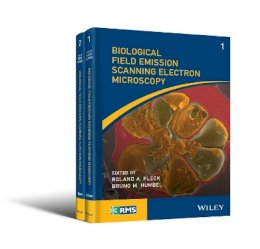ROLAND A. FLECK, PHD, FRCPath, FRMS, is a Professor in Ultrastructural Imaging and Director of the Centre for Ultrastructural Imaging at King's College London. Having specialised in basic research into cellular injury at low temperatures and during cryo-preservation regimes he has developed specialist knowledge of freeze fracture/freeze etch preparation of tissues and wider cryo-microscopic techniques. As director of the Centre for Ultrastructural Imaging he supports advanced three dimensional studies of cells and tissues by both conventional room temperature and cryo electron microscopy. He is a visiting Professor of the Faculty of Health and Medical Sciences, University of Copenhagen and Professor of the UNESCO Chair in Cryobiology, National Academy of Sciences of Ukraine, Institute for Problems of Cryobiology, Kharkiv, Ukraine. BRUNO M. HUMBEL, Dr. sc. nat. ETH, is head of the Imaging Section at the Okinawa Institute of Science and Technology, Onna son, Okinawa, Japan. He is awarded a research professorship at Juntendo University, Tokyo, Japan. He got his PhD at the Federal Institute of Technology, ETH, Zurich, Switzerland, with Prof. Hans Moor and Dr. Martin Müller, both pioneers in cryo-electron microscopy (high-pressure freezing, freeze-fracturing, freeze-substitution and low-temperature embedding, cryo-SEM, cryo-sectioning). His research focuses on sample preparation for optimal, life-like imaging of biological objects in the electron microscope. The main interests are preparation methods based on cryo-fixation applied in Cell Biology. From here, hybrid follow-up methods like freeze-substitution or freeze-fracturing are used. He is also involved in immunolabelling technology, e.g., ultra-small gold particles and has been working on techniques for correlative microscopy and volume microscopy for a couple of years. He teaches cryo-techniques and immunolabelling and correlative microscopy in international workshops and has professional affiliations with Zhejiang University, Hangzhou, People's Republic of China as a distinguished professor and co-director of the Center of Cryo-Electron Microscopy and with the Federal University of Minas Gerais, Belo Horizonte, Brazil, as a FAPEMIG visiting professor at the Centro de Microscopia da UFMG.
Since the first commercial SEM (scanning electron microscope) was produced by Cambridge Instruments in 1965, the resolution,image contrast, and operability have improved dramatically which have turned field emission SEM into an increasingly valuable tool in the life science community. The challenge of life science microscopy is to provide the structural information for the correlation of structure and function in complex biological systems. For this reason, this two-volume edition comes as a welcome addition to the biologist’s library, since they encompass all the information needed to approach life science FEG SEM imaging challenges, including detailed descriptions of the instrumentation and analytical techniques currently available in the field. There are many features of this edition that make it a useful resource for both the beginner and more advanced microscopist. First, the two volumes are composed of 31 self-contained chapters, each written by leading authorities on these subjects. Secondly, the chapters are richly illustrated and most chapters are complemented with a comprehensive, valuable, and up-to-date list of references. Accordingly, the user who seeks to purchase new equipment or select the appropriate technique will find useful information in both volumes. In the initial nine chapters of vol. 1, the reader is given a comprehensive historical review and introduction to the possibilities of the current technology—choice of microscopy method and specimen preparation as well as cryo and room temperature options—edited by representatives from the major companies in the field. The three last chapters of vol. 1 are dedicated to a review of specimen preparation methods—chemical fixation and cryo methods—which are a must-read for any scientist in this field. In vol. 2 in the first five chapters, the reader is introduced to more special applications and results of the techniques, spanning from pathology and infectious diseases, plant cell wall and nuclear envelope, yeast cell to food research. The three following chapters focus on cryo-FEGSEM in biology, preparation protocols of vitrified cells for cryo-FIB microscopy, and ESEM (environmental scanning electron microscopy) including many valuable tips and tricks. Opportunities for "Life in 3D" research are described in great detail with chapters on Correlative Array Tomography and the Automatic Tape Collection Microtome followed by chapters on FIB-SEM for Biomaterials, FIB-SEM tomography, and 3D FEGSEM as a tool for structural biology. Vol. 2 is concluded with three chapters on image post-processing and resource management, which are relevant to all scientists—not just FEG SEM microscopists. In conclusion, I highly recommend Biological Field Emission Scanning Electron Microscopy to anybody who wishes to implement and/or improve an available technology or method. This two-volume edition allows the reader to contemplate how to use existing equipment with some minor adjustments or simple application of sample preparation and analytical tools. Furthermore, this book provides a comprehensive analysis of the latest imaging technologies available in the field and should therefore be invaluable to any researcher who wishes to find a discussion of all these techniques and applications under one umbrella. —Microscopy and Microanalysis (2020) Klaus Qvortrup, Faculty of Health Sciences, University of Copenhagen, The Panum Institute, Denmark

